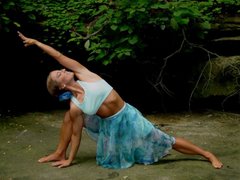You may not believe this, but even those of us who can put our foot behind our head will encounter post-workout body tightness -- you know the feeling, that sensation that hastens your breath and renders all sorts of grunts and facial contortions as you gingerly attempt to untangle stubbornly knotted muscles. For me, this especially happens after I've finished a run, the result of my hamstrings and calf muscles firing a bit too enthusiastically. To counter this effect (and to avoid feeling like Frankenstein the next morning), over the years I have developed a series of post-run stretches that elongate the back of my legs quite nicely. Even so, there's just no avoiding the plain fact that the first couple of stretches after the run will be a bit agonizing, as the muscles are still in "contracting" mode, where all I can do is try to calm my breathing and concentrate on relaxing. For this reason, I always start out with lighter, more cautious stretches, then progress gradually to the more extreme positions. And like magic, ten minutes later I feel great, having returned to my high-kicking full mobility.
Now, while high kicks may not be in the cards for you, you can still successfully apply this same principle to your stretching. All too often, people cut off their stretching session when their muscles haven't even begun to open up, and then wonder why they're not seeing any changes in their flexibility! The key is to perform each stretch a minimum of three times. The first time is essentially just a warm-up; you're introducing your muscle to the position, getting a feel for how tight it is, and beginning the process of breathing through the stretch. The second time around is when you start to improve upon the quality of the stretch, and increase the duration of it. You should start to see a little improvement from the first time you assumed the stretch, but you're still not finished. The THIRD time is when the real benefit kicks in. This is when you want to extend the stretch -- both time-wise and position-wise -- to the maximum point your body is capable of comfortably holding. THIS is how you make progress with your stretching, and this is how to best encourage a swift recovery from your workouts.
Saturday, June 9, 2007
Subscribe to:
Post Comments (Atom)


No comments:
Post a Comment